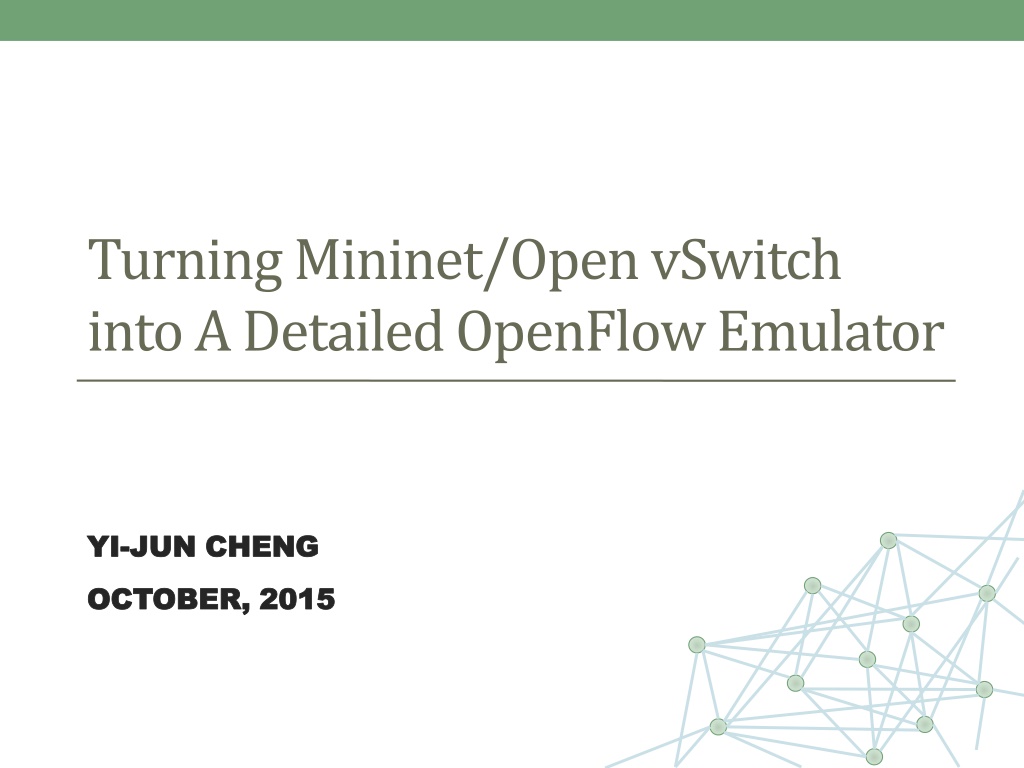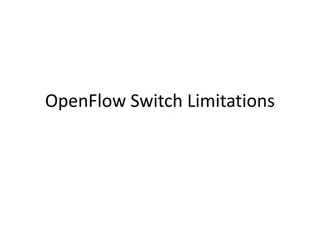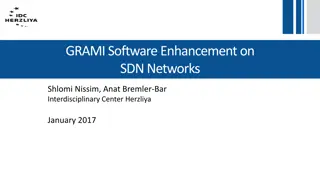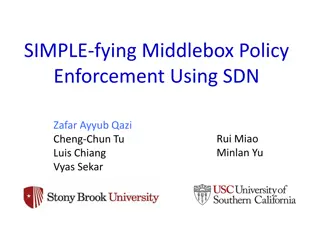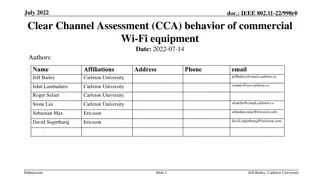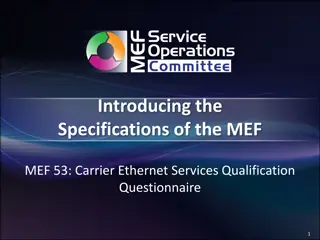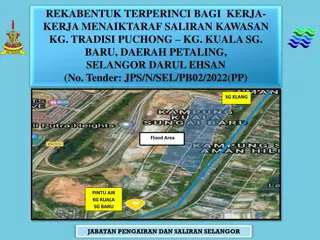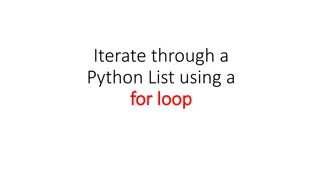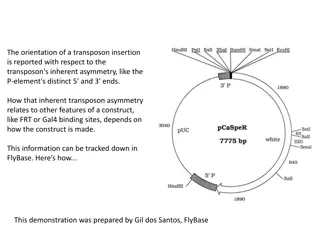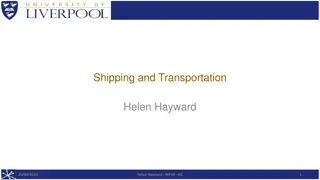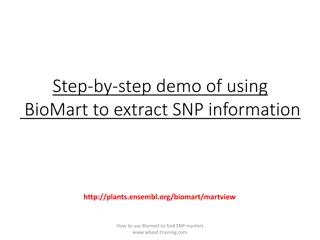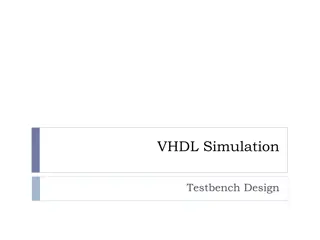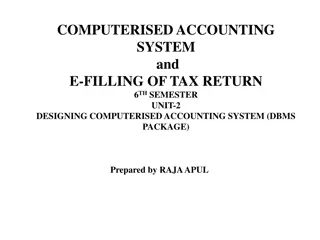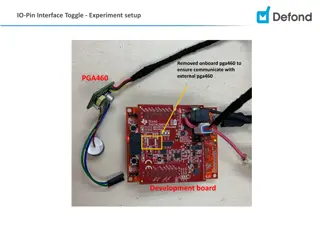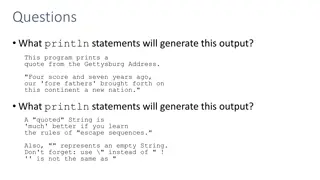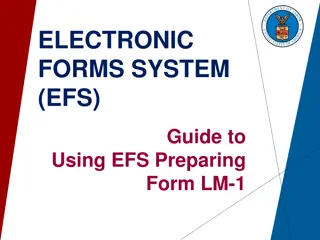Detailed OpenFlow Emulation Using Mininet/OpenvSwitch
Emerging network architectures like Software-Defined Networking (SDN) require detailed emulation and performance evaluation. Researchers focus on SDN and OpenFlow to improve network programmability and management. This involves creating accurate emulations to support various switch implementations and performance benchmarks. Measurement studies are conducted on OpenFlow switches like Pica8 P-3297 and Open vSwitch to analyze control and data plane performance. Tools like OFLOPS are used for performance measurements.
Download Presentation

Please find below an Image/Link to download the presentation.
The content on the website is provided AS IS for your information and personal use only. It may not be sold, licensed, or shared on other websites without obtaining consent from the author. Download presentation by click this link. If you encounter any issues during the download, it is possible that the publisher has removed the file from their server.
E N D
Presentation Transcript
Turning Mininet/OpenvSwitch into A Detailed OpenFlow Emulator YI YI- -JUN CHENG JUN CHENG OCTOBER, 2015 OCTOBER, 2015
2 Emerging Network Architecture Software-Defined Networking provides network programmability and efficient network management Researchers from academia and industry worked on developing innovative network services on SDN and OpenFlow Behavior verifications and performance evaluations are necessary to examine the possibilities of the novel ideas
3 References: [1] M. Kobayashiand S. Seetharaman and G. Parulkarand G. Appenzellerand J. Littleand J. Reijendamand P. Weissmann and N. McKeown. Maturing of OpenFlow and Software-defined Networking through Deployments. Computer Networks, 61:151 175, November 2013.
4 OpenFlow Simulators/Emulators Testbeds are necessary, but deploying ones is costly, time- consuming, and labor-intensive Run emulations/simulations beforehand Several available emulators/simulators, but fail to consider control plane performances and different switch implementations References: [1] Mininet: an instant virtual network on your laptop (or other PC). http://mininet.org
5 Goal Accurately emulate both behaviors and performances of SDN- based networks and support different switch implementations Design measurement studies for switch performances and propose performance benchmarks Propose performance models and switch-dependent parameters, Integrate with an OpenFlow emulator, Mininet/OVS Preliminary Measurements Offline Profiling Switch Pica8 P- 3297 Open vSwitch Parameter Configuration Files Automatic Profiling Procedures Measurement Study Performance Models Switch- specific Parameters Models Automatic Profiling Procedure s Accurate OpenFlow Emulation Switch States Emulator
6 Measurement Methodology Conduct measurement studies on OpenFlow switches, Pica8 P-3297 and Open vSwitch Control plane performance measurements Flow table update delay Develop our testing modules based on OFLOPS Data plane performance measurements Packet forwarding latency and throughput Use OFLOPS with packet replay and capture tools OFLOPS
7 Measurement Setup Dedicated control plane channel Event Scheduler, Data Plane Traffic Generator, and Packet Handler are three main threads in OFLOPS framework Control Plane Packets Data Plane Packets CPU: Intel i7 3.6 GHz Memory: 8 GB OpenFlow Controller Events Data Plane Traffic Generator Packet Handler Event Scheduler Gigabit Ethernet Switch Under Test Data Plane Channels Control Plane Channel
8 What Each Component Does Event Scheduler defines how each event works Data Plane Traffic Generator generates customized data plane packets and send them via data plane channels Packet Handler captures packets from both data plane and control plane channels Control Plane Packets Data Plane Packets OpenFlow Controller Events Data Plane Traffic Generator Packet Handler Event Scheduler Switch Under Test Data Plane Channels Control Plane Channel
9 Control Plane Performance Measurement Studies and Modeling Test Scenarios Measurement Results Performance Models Model Validation
10 Factor Considerations for Control Plane Performance Tests Performance metrics Flow table update delay Flow_mod command types Insertion, modification, and deletion commands Number of existing flows Priority distribution of existing flows Descending, ascending, and same priority distributions Number of batch commands How many commands waiting for execution
11 Control Plane Tests Preinstall different number of flows with different priority distributions at first for each of the test Insertion test Send different number of insertion commands under different number of existing flows Modification test Send different number of modification commands under different number of existing flows Deletion test Send a wild-carded command to delete flows in the table Show sample results from Pica8 in the following
12 Insertion Test Results on Pica8 Proportional to existing flow size Different increasing rate for different batch command size Increasing rate decreases with more batch commands Similar observations in software table Descending priority distribution Same priority distribution
13 Insertion Test Results on Pica8 (cont.) Flows should be in priority order in TCAM Flow shifting time dominates the insertion delays, so little differences observed among different batch command sizes Ascending priority distribution
14 Modification Test Results on Pica8 Proportional to existing flow size Increasing rate decreases with more batch commands Different increasing rates for different priority distributions Ascending priority distribution Same priority distribution
15 Deletion Test Results on Pica8 Proportional to number of deleted flows Existing flows with different priority distributions share same results Same priority distribution Ascending priority distribution
16 Insertion Time Model c denotes the index of flow_mod command t is the index of the table Proportional to existing flow size P Decrease with more batch commands R(q) Sis flow shifting time Wis the time to update a flow table entry table, t Priority distribution Command type, fc # batch commands, q # existing flows, e Shifting times, s Insertion Time Model Dadd
17 Modification Time Model T denotes number of tables Proportional to existing flow size P Decrease with more batch commands R(q) M is the time for searching matching flows m denotes the number of matched flows Priority distribution Command type, fc # batch commands, q # existing flows, e # matched flows, m Modification Time Model Dmod
18 Deletion Time Model # matched flows, m Deletion Time Model M time for searching all matched m flows W time for updating a flow entry Ddel
19 Validation Experiments Test scenarios Insertion tests Modification tests Deletion tests Random tests Random priorities, IP addresses, arrival time, and command types Validation results from Pica8 and OvS
20 Insertion Test Validation Validation results using ascending priority distribution Modeled results follow the results of OpenFlow switches Pica8 P-3297 Open vSwitch
21 Modification Test Validation Validation results using ascending priority distribution Modeled results follow the results of OpenFlow switches Pica8 P-3297 Open vSwitch
22 Deletion Test Validation Validation results using ascending priority distribution Modeled results follow the results of OpenFlow switches Pica8 P-3297 Open vSwitch
23 Random Test Validation Random commands, priorities, IP addresses, and arrival time Arrival time follows Poisson process with 100 flows/sec 16 random configurations for each command size Error rates are mostly under 20% on Pica8 and OvS Pica8 P-3297 Open vSwitch
24 Data Plane Performance Measurement Studies and Modeling Test Scenarios Measurement Results Performance Models Model Validation
25 Factor Considerations for Data Plane Performance Tests Different matching fields used of tables flows L2, L3, and both L2 and L3 Number of existing flows in the flow table Inter-packet time Time difference between last packet and current packet arrival time Packet size
26 Data Plane Tests Performance metrics Forwarding delay Throughput Preinstall corresponding flows for data plane traffic, with: Different existing flow size Different matching fields used Send data plane traffic, with: Different packet size Different inter-packet time
27 Packet Sizes and Matching Fields Larger packet sizes result in higher forwarding delays Delay time varies with different matching fields used Pica8 P-3297 Open vSwitch
28 Existing Flow Sizes Existing flow sizes have little impact on forwarding delays Pica8 P-3297 Open vSwitch
29 Inter-packet Time Multi-levels of forwarding delays with different inter-packet time Pica8 P-3297 Open vSwitch
30 Packet Forwarding Delay Model k denotes the index of the data plane packet denotes the base time : increasing rate for inter-packet time, ak : increasing rate for existing flow size, ek : increasing rate for packet size, bk Inter-packet time, a Existing flow size, e Packet size, b Packet Forwarding Delay Model Ddelay
31 Validation Experiments Test scenarios Different packet sizes Different existing flow sizes Different inter-packet time Real world data plane traffic Pcap trace collected from an educational site Validation results from Pica8 and OvS
32 Validation Results -Different Packet Sizes 500 flows with L2/L3 matching fields used in the table Inter-packet time of 100 us packets sent Modeled results follow the result of real OpenFlow switch Open vSwitch Pica8 P-3297
33 Validation Results -Different Existing Flow Sizes L2/L3 matching fields used in the table Packet size of 128 bytes, inter-packet time of 100 us packets are sent Pica8 P-3297 Open vSwitch
34 Validation Results -Different Inter-packet Time 500 flows with L2/L3 matching fields used in the table Packet size of 128 bytes are sent Pica8 P-3297 Open vSwitch
35 Validation Results -Real World Data Plane Traffic Traces collected from a educational organization, with hundreds of students and employees in 2007, and over 200,000 packets captured Randomly select packets among 200,000 packets 16 different ranges for each number-of-packet sample Open vSwitch Pica8 P-3297
36 Emulator Implementations and Evaluations
37 Emulator Implementation OpenFlow Event Detector extracts flow_mod events from controller/switch message and put them into OpenFlow Event Queue OpenFlow Event Handler fetches events from the queue and manipulate the events Clock Time Manager calculates modeled time and adjusts the time Switch State Maintainer updates switch states Statistics Reporter records each command information and performance controller/switch messages OpenFlow Event Detector Add, modify, delete commands OpenFlow Event Queue Add, modify, delete commands OpenFlow Event Handler Add, modify, delete commands Clock Time Manager Switch State Maintainer Statistics Reporter Control Plane Statistics Configuration File
38 Evaluations Insertion/modification command tests Performance accuracy is much better than original Mininet/OvS Insertion Modification
39 Evaluations (cont.) Deletion tests No differences between our emulator and real Pica8 results Deletion
40 Conclusion and Future Work Switch Performance Benchmark Propose automatic procedures for switch performance benchmarking Performance Model and Switch-dependent Parameters Propose control plane and data plane performance models for diverse OpenFlow switches Emulator Implementation Integrate performance models with OpenFlow emulator, Mininet/OvS Future directions Adjustments on control plane performance models Emulator implementation for data plane performance model, and thorough evaluations of the emulator using real-world traces Update OFLOPS for OpenFlow higher versions support
41 Thanks much for your listening! Thanks much for your listening! Q A
42 Different Priority Distributions
43 Why OFLOPS? Barrier reply message should notify the completion of a series of commands sent before the barrier request message Not correctly implemented in all OpenFlow switches
44 Switch Benchmark Tool Benchmark tool Data plane profiling experiments Control plane profiling experiments Any OpenFlow switch Flow insertion time Flow Flow deletion time Packet forwarding latency modification time Throughput Sample figures
